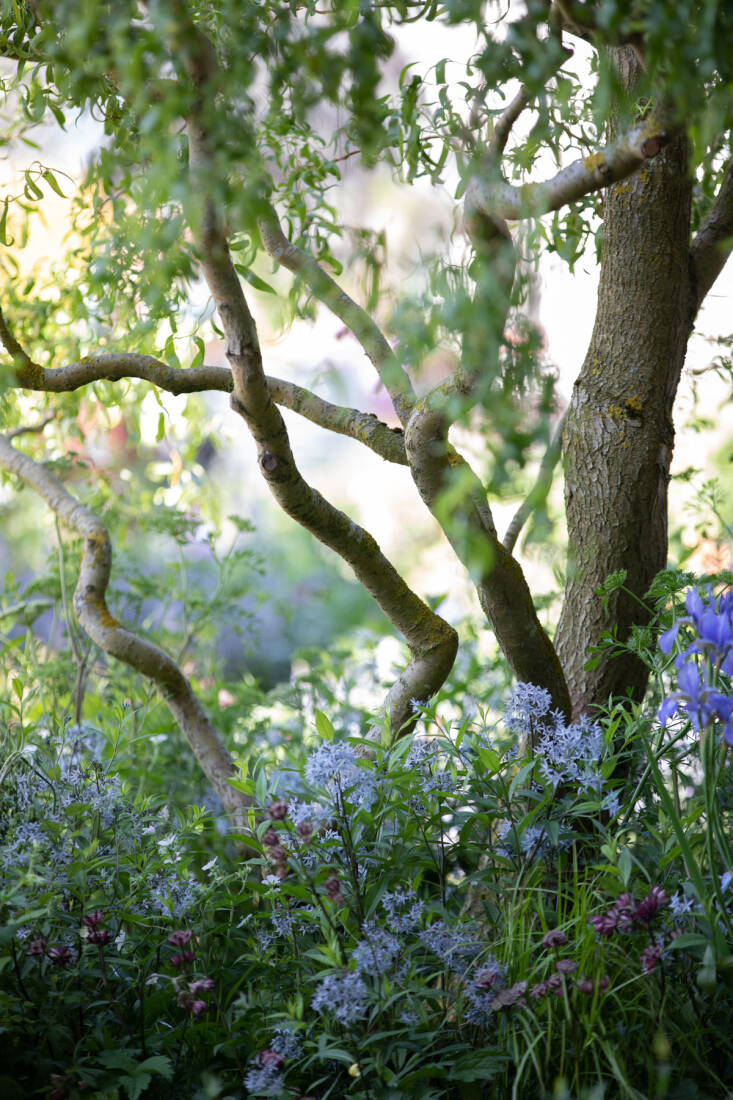It’s hard to imagine a richer source of aesthetic inspiration than William Morris, who brought nature, pattern, and color into the homes of Victorian England and spearheaded the Arts & Crafts movement. So it makes sense that when garden designer Ruth Willmott was tasked with creating a garden for Morris & Co she began by looking at some of the polymath designer’s best known patterns and then used two of them, Willow Boughs and Trellis, as the foundation for her garden at this year’s Chelsea Flower Show.
Photography by Richard Bloom unless otherwise noted.

The angular Trellis, the first wallpaper Morris created in 1862, provided the very simple but effective grid of paths that form the main structure of the space and delineate the planting areas, which are filled with a repeating pattern of plants across the garden. Morris’ perennially popular Willow Boughs, meanwhile, inspired the beautiful trees—willows that are twisted (Salix matsudana ‘Tortuosa’) or pollarded or left to grow tall like the white willow. “The different shapes illustrate just how versatile the tree is. People think of the willow as always being huge but you can keep them smaller,” says Ruth. Its versatility is then echoed with willow panels, made by Suffolk-based weaver Peter Dibble, that screen the back of the garden.

The same two patterns come together in a central metal pavilion, laser-cut and finished in a deep rust red shade, that casts beautiful shadows across a seating area. Just as craftsmanship was at the very heart of William Morris’ work, so too does it underpin the whole ethos of Ruth’s scheme. The clay tiles that form shallow steps were made by hand, riven buff Yorkstone is used as paving, while offcuts of the same stone are cut into more contemporary shapes to form low walls.


All of this is contrasted with soft and romantic plantings that include lots of cottage garden favorites—iris, aquilegia, nepeta, poppies, and foxgloves—but in a medieval inspired palette with blue and apricot contrasted with deep reds and purples that gives these planting squares big impact.

Morris’ oft-quoted mantra—“Have nothing in your houses that you do not know to be useful or believe to be beautiful”— is as relevant today as it was 180 years ago, possibly even more relevant when we are evaluating our homes as never before. The same idea could be applied to our gardens, too; minimize the hard landscaping (here, Ruth says, she’s used about 75% of the area for plants) and invest in pollinator-rich plants, native trees, and hedging with real wildlife benefit. There’s a psychological benefit, too, of course; after the show, the garden will be dissembled and then rebuilt in community gardens on the Packington Estate in north London, bringing this beautifully crafted garden to inner city housing, just a stone’s throw away from where some of William Morris’s designs were first printed.
For more on the Chelsea Flower Show, see:
- Chelsea Flower Show 2022 Preview: Wilderness and Wattling
- Chelsea Flower Show 2021: A Master Class in Autumn Color
- Container Gardening at the Chelsea Flower Show: A Tiny Garden with a Big Message









Have a Question or Comment About This Post?
Join the conversation